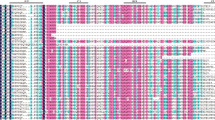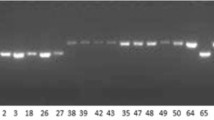Abstract
In plant populations exhibiting gametophytic self-incompatibility, individuals harbouring rare S alleles are likely to have a reproductive advantage over individuals having more common alleles. Consequently, determination of the self-incompatibility haplotype of individuals is essential for genetic studies and the development of informed management strategies. This study characterises six new S alleles identified in wild cherry (Prunus avium L.). Investigations to determine the S genotype of individuals in recently planted woodland through length polymorphisms of introns associated with the stylar S-RNase gene and the pollen SFB gene revealed six S intron profiles which did not correspond to those of known S alleles. These are now attributed to S 27 to S 32 . Consensus primers, annealing in the S-RNase sequence coding for the signal peptide and C5 regions, were used to isolate the S-RNase alleles associated with the novel S intron profiles. The proteins corresponding to the new alleles were separated by isoelectric focusing from stylar extracts and their pI values determined. Similarities between the deduced amino acid sequence for the new alleles isolated and other cherry S-RNase sequences available on the databases ranged from 40% to 86%. Amplification products for SFB introns ranged from 172 to 208bp. New sequence regions exposed to positive selection were identified and the significance of the PS3 region reinforced. A phylogenetic relationship between P. avium S-RNases for S 10 and S 13 and between corresponding SFB alleles may indicate co-evolution of allele specificities of these two genes.





Similar content being viewed by others
References
Bošković R, Tobutt KR (1996) Correlation of stylar ribonuclease zymograms with incompatibility alleles in sweet cherry. Euphytica 90:245–250
Bošković R, Tobutt KR (2001) Genotyping cherry cultivars assigned to incompatibility groups, by analysing stylar ribonucleases. Theor Appl Genet 103:475–485
Bošković RI, Wolfram B, Tobutt KR, Cerovic R, Sonneveld T (2006) Inheritance and interactions of incompatibility alleles in the tetraploid soar cherry. TAG 112:315–326
Castric V, Vekemans H (2004) Plant self-incompatibility in natural populations: a critical assessment of recent theoretical and empirical advances. Mol Ecol 13:2873–2889
Chung BYW, Simons C, Firth AE, Brown CM, Hellens RP (2006) Effect of 5′UTR introns on gene expression in Arabidopsis thaliana. BMC Genomics 7:120
Crane MB, Brown AG (1937) Incompatibility and sterility in the sweet cherry, Prunus avium L. J Pomol Hortic Sci 15:86–116
Crane MB, Lawrence WJC (1929) Genetical and cytological aspects of incompatibility and sterility in cultivated fruits. J Pomol Hortic Sci 17:276–301
De Cuyper B, Sonneveld T, Tobutt KR (2005) Determining self-incompatibility genotypes in Belgian wild cherries. Mol Ecol 14:945–955
de Nettancourt D (2001) Incompatibility and incongruity in wild and cultivated plants. Springer, Berlin
Ducci F, Santi F (1998) The distribution of clones in managed and unmanaged populations of wild cherry (Prunus avium). Can J For Res 27:1998–2004
Entani T, Iwano M, Shiba H, Che FS, Isogai A, Takayama S (2003) Comparative analysis of the self-incompatibility (S-) locus region of Prunus mume: identification of a pollen-expressed F-box gene with allelic diversity. Genes Cells 8:203–213
Franklin-Tong N, Franklin FCH (2003) Gametophytic self-incompatibility inhibits pollen tube growth using different mechanisms. Trends Plant Sci 8:598–605
Igic B, Kohn JR (2001) Evolutionary relationships among self-incompatibility RNases. Proc Natl Acad Sci U S A 98:13167–13171
Ikeda K, Igic B, Ushijima K, Yamane H, Hauck NR, Nakano R et al (2004) Primary structural features of the S haplotype-specific F-box protein, SFB, in Prunus. Sex Plant Reprod 16:235–243
Ishimizu T, Endo T, Yamaguchi-Kabata Y, Nakamura KT, Sakiyama F, Norioka S (1998) Identification of regions in which positive selection may operate in S-RNase of Rosaceae, Implication for S-allele-specific recognition sites in S-RNase. FEBS Lett 440:337–342
Kato S, Mukai Y (2004) Allelic diversity of S-RNase at the self-incompatibility locus in natural flowering cherry populations (Prunus lannesiana var. speciosa). Heredity 92:249–256
Ma RC, Oliveira MM (2002) Evolutionary analysis of S-RNase genes from Rosaceae species. Mol Genet Genom 267:71–78
McClure B (2006) New views of S-RNase-based self-incompatibility. Curr Opin Plant Biol 9:639–646
McCubbin AG, Kao TH (2000) Molecular recognition and response in pollen and pistil interactions. Annu Rev Cell Dev Biol 16:333–364
Ortega E, Boskovic RI, Sargent DJ, Tobutt KR (2006) Analysis of S-RNase alleles of almond (Prunus dulcis): characterization of new sequences, resolution of synonyms and evidence of intragenic recombination. MGG 276:413–426
Page RDM (1996) TREEVIEW: an application to display phylogenetic trees on personal computers. Comput Appl Biosci 12:357–358
Romero C, Vilanova S, Burgos L, Martinez-Calvo J, Vicente M, Llacer G, Badenes ML (2004) Analysis of the S-locus structure in Prunus armeniaca L. Identification of S-haplotype specific S-RNase and F-box genes. Plant Mol Biol 56:145–157
Rozas J, Sanchez-DelBarrio J, Messeguer X, Rozas R (2003) DnaSP, DNA polymorphism analyses by the coalescent and other methods. Bioinformatics 19:2496–2497
Sassa H, Nishio T, Kowyama Y, Hirano H, Koba T, Ikehashi H (1996) Self incompatibility (S) alleles of the Rosaceae encode members of a distinct class of the T-2/S ribonuclease superfamily. Mol Gen Genet 250:547–557
Schueler S, Tusch A, Scholz F (2006) Comparative analysis of the within-population genetic structure in wild cherry (Prunus avium L.) at the self-incompatibility locus and nuclear microsatellites. Mol Ecol 15:3231–3243
Sonneveld T, Robbins TP, Boskovic R, Tobutt KR (2001) Cloning of six cherry self-incompatibility alleles and development of allele-specific PCR detection. Theor Appl Genet 102:1046–1055
Sonneveld T, Tobutt KR, Robbins TP (2003) Allele-specific PCR detection of sweet cherry self-incompatibility (S) alleles S1 to S16 using consensus and allele-specific primers. Theor Appl Genet 107:1059–1070
Sonneveld T, Robbins TP, Tobutt KR (2006) Improved discrimination of self-incompatibility S-RNase alleles in cherry and high throughput genotyping by automated sizing of first intron PCR products. Plant Breed 125:305–307
Sonneveld T, Tobutt KR, Vaughan SP, Robbins TP (2005) Loss of pollen-S function in two self-compatible selections of Prunus avium is associated with deletion/mutation of an S haplotype-specific F-box gene. Plant Cell 17:37–51
Steinbachs JE, Holsinger KE (2002) S-RNase-mediated gametophytic self-incompatibility is ancestral in eudicots. Mol Biol Evol 19:825–829
Stoeckel S, Grange J, Fernandex-Manjarres FJ, Bilger I, Frascaria-Lacoste N, Mariette S (2006) Heterozygote excess in a self-incompatible and partially clonal forest tree species Prunus avium L. Mol Ecol 15:2109–2118
Šurbanovski N, Tobutt KR, Konstantinović M, Maksimović V, Sargent DJ, Stevanović V et al (2007) Self-incompatibility of Prunus tenella and evidence that reproductively isolated species of Prunus have different SFB alleles coupled with an identical S-RNase allele. Plant J 50:723–734
Tao R, Yamane H, Sugiura A, Murayama H, Sassa H, Mori H (1999) Molecular typing of S-alleles through identification, characterization and cDNA cloning for S-RNases in sweet cherry. J Am Soc Hortic Sci 124:224–233
Thompson JD, Higgins DG, Gibson TJ (1994) Clustal W: improving the sensitivity of progressive multiple sequence alignment through sequence weighting, positions-specific gap penalties and weight matrix choice. Nucleic Acid Res 22:4673–4680
Ushijima K, Sassa H, Tao R, Yamane H, Dandekar AM, Gradziel TM et al (1998) Cloning and characterization of cDNAs encoding S-RNases from almond (Prunus dulcis): primary structural features and sequence diversity of the S-RNases in Rosaceae. Mol Gen Genet 260:261–268
Ushijima K, Sassa H, Dandekar AM, Gradziel TM, Tao R, Hirano H (2003) Structural and transcriptional analysis of the self-incompatibility locus of almond: identification of a pollen-expressed F-box gene with haplotype-specific polymorphism. Plant Cell 15:771–781
Ushijima K, Yamane H, Watari A, Kakehi E, Ikeda K, Hauck NR, Iezzoni AF, Tao RT (2004) The S haplotype-specific F-box protein gene, SFB, is defective in self-compatible haplotypes of Prunus avium and P. mume. Plant J 39:573–586
Vaughan SP, Russell K (2004) Characterisation of novel microsatellites and development of multiplex PCR for large-scale population studies in wild cherry, Prunus avium L. Mol Ecol Notes 4:429–431
Vaughan SP, Russell K, Sargent DJ, Tobutt KR (2006) Isolation of S locus F-box alleles in Prunus avium and their application in a novel method to determine self-incompatibility genotype. Theor Appl Genet 112:856–866
Vaughan SP, Cottrell JE, Moodley DJ, Connelly T, Russell K (2007a) Distribution and fine-scale spatial-genetic structure in British wild cherry (Prunus avium L). Heredity 98:274–283
Vaughan SP, Cottrell JE, Moodley DJ, Connelly T, Russell K (2007b) Clonal structure and recruitment in British wild cherry (Prunus avium L). For Ecol Man 242:419–430
Wiersma PA, Wu Z, Zhou L, Hampson C, Kappel F (2001) Identification of new self-incompatibility alleles in sweet cherry (Prunus avium L.) and clarification of incompatibility groups by PCR and sequencing analysis. Theor Appl Genet 102:700–708
Wunsch A, Hormaza JI (2004) Cloning and characterization of genomic DNA sequences of four self-incompatibility alleles in sweet cherry (Prunus avium L.). Theor Appl Genet 108:299–305
Yamane H, Ikeda K, Ushijima K, Sassa H, Tao R (2003a) A pollen-expressed gene for a novel protein with an F-box motif that is very tightly linked to a gene for S-RNase in two species of cherry, Prunus cerasus and P. avium. Plant Cell Physiol 44:764–769
Yamane H, Ushijima K, Sassa H, Tao R (2003b) The use of the S haplotype-specific F-box protein gene, SFB as a molecular marker for S-haplotypes and self-compatibility in Japanese apricot (Prunus mume). Theor Appl Genet 107:1357–1361
Acknowledgements
This research was supported by funding from Defra and the Forestry Commission (Grant No.WD0502). The authors would also like to thank Bart De Cuyper and Dr. Tineke Sonneveld for provision of primers and P. avium material and for helpful discussions. Radovan Bošković acknowledges a grant from the Mount Trust.
Author information
Authors and Affiliations
Corresponding author
Additional information
Communicated by A. Abbott
The nucleotide sequences reported in this paper have been submitted to the EMBL/GenBank database under the following accession numbers: S 27 (DQ266439), S 28 (DQ266440), S 29 (DQ266441), S 30 (DQ266442), S 31 (DQ266443), S 32 (DQ266444).
Rights and permissions
About this article
Cite this article
Vaughan, S.P., Bošković, R.I., Gisbert-Climent, A. et al. Characterisation of novel S-alleles from cherry (Prunus avium L.). Tree Genetics & Genomes 4, 531–541 (2008). https://doi.org/10.1007/s11295-007-0129-6
Received:
Revised:
Accepted:
Published:
Issue Date:
DOI: https://doi.org/10.1007/s11295-007-0129-6




